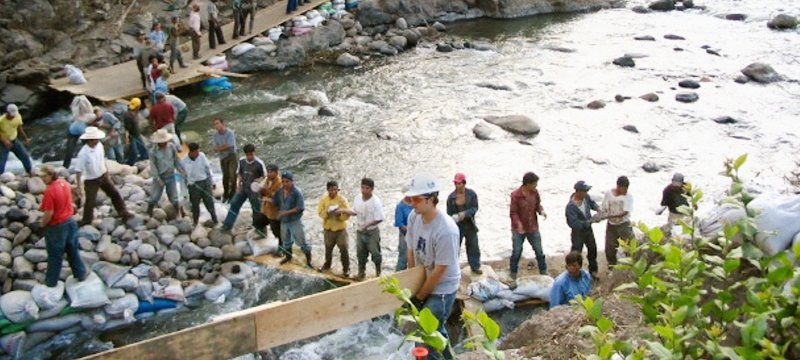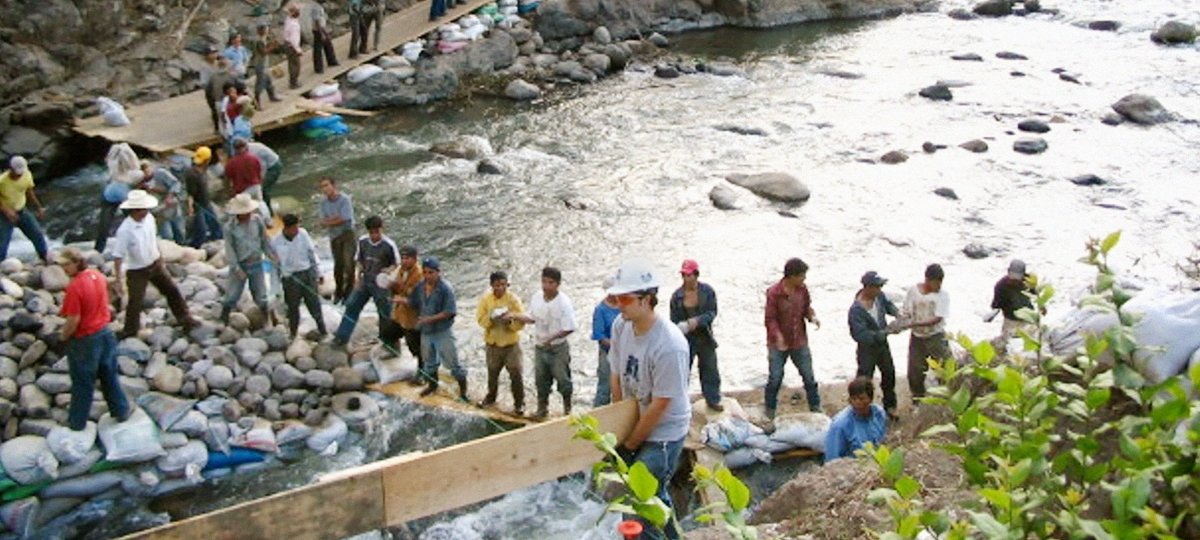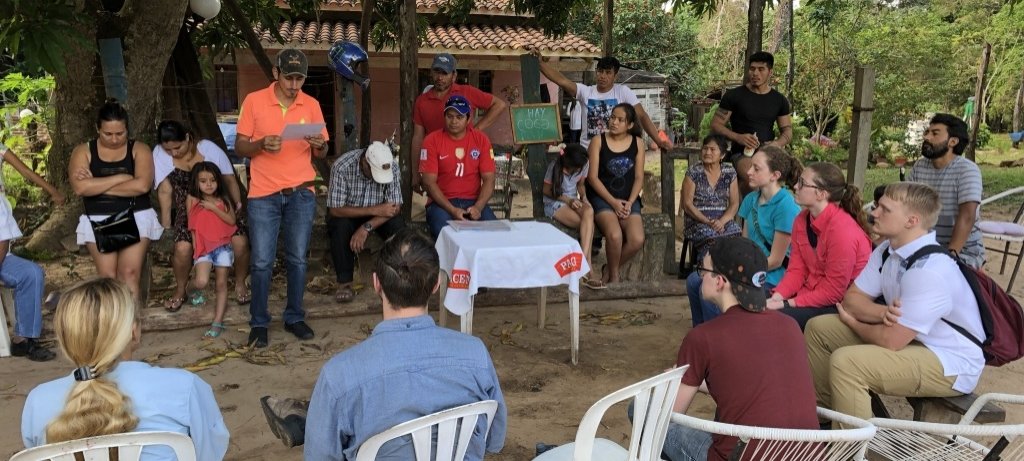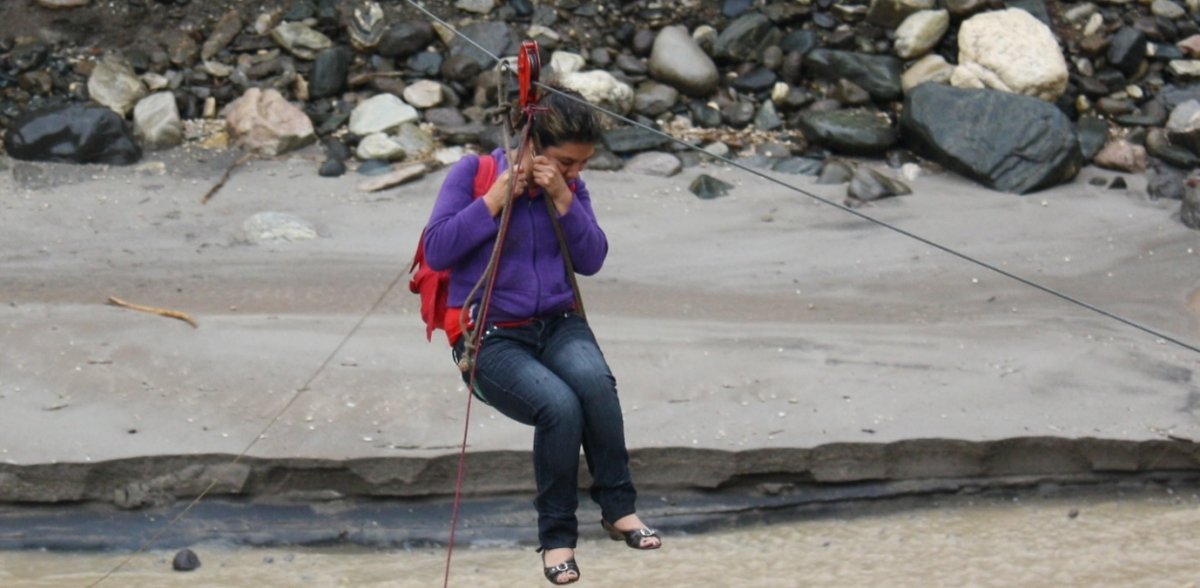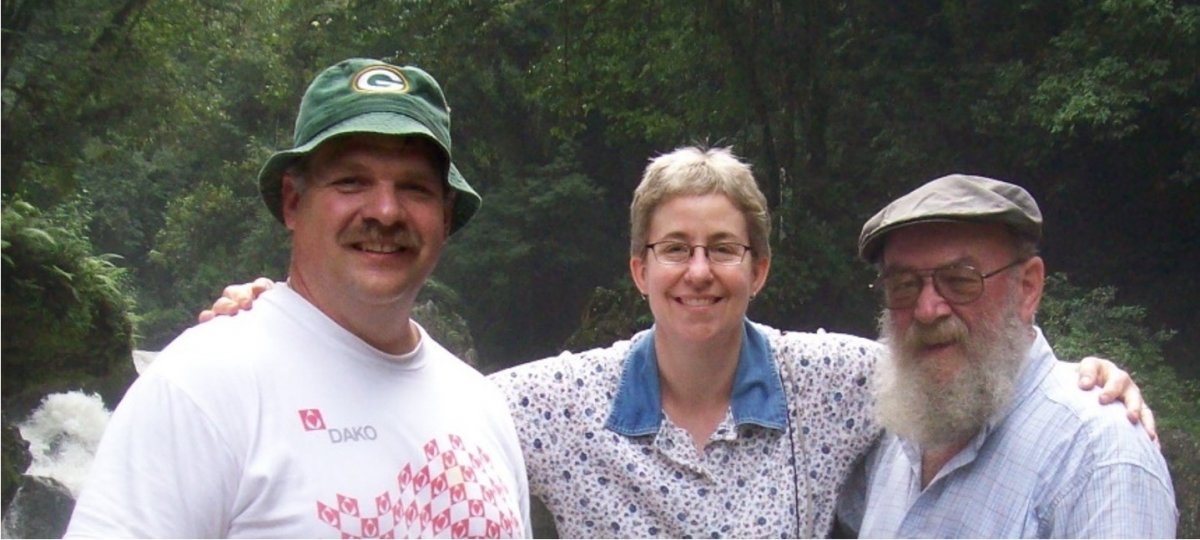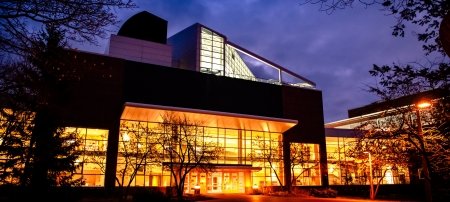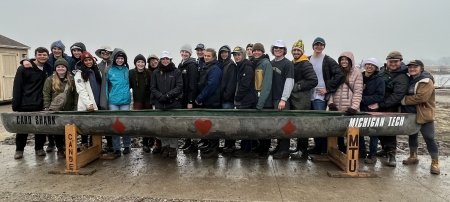Passion, the desire to help others, and skill sharing define Michigan Tech’s Engineers Without Borders student chapter.
Community is one of the Michigan Tech values, nestled nicely with accountability and tenacity, and many an MTU grad hold those values as guiding principles in their lives. But what does it look like to put those values into action? That’s the subject of alumnus Mike Paddock’s 2020 book, Bridging Barriers: How a Community Changed Its Future with Help From Engineers Without Borders USA Volunteers.
Engineers Without Borders USA (EWB) has an ambitious mission: to build a better world by harnessing the transformative potential of engineering. The organization builds bridges, establishes renewable power generation stations, improves access to clean water, and conducts other projects that make it possible for communities to move forward to meet their basic human needs.
Leadership and Service
It’s no coincidence that Michigan Tech’s student Engineers Without Borders chapter was an early member of the organization; recently retired civil engineer and alumna Cathy Leslie ‘83 led the organization from 2004 until this year. Read about Leslie’s service and advice to students on Unscripted.
Many engineers choose the profession because they want to help other people. EWB offers a long-standing, effective way to channel valuable skills and that desire to be of service into meaningful projects. Students, often among the most passionate about helping communities help themselves, don’t have to wait to be fully certified practicing engineers to get involved. They can begin outreach while they work for their engineering degrees. Michigan Tech’s student EWB chapter is one of the earliest, and remains active.
Helping communities help themselves is a key EWB tenet. It’s important because after the volunteer engineers pack up and head home, citizens will need to sustain the improvements. That’s why EWB’s volunteer engineers train community members to be able to lead and participate in infrastructure projects. At the same time, they provide student engineers-in-training to hone their technical and leadership skills.
In 2002, EWB was founded, giving structure and professional guidelines to previously ad hoc engineering volunteerism.
Living relatively close to MTU in Wisconsin, Paddock was an early supporter of Michigan Tech’s EWB student chapter, one of the earliest such chapters in existence. Faculty members David Watkins and Norma Veurink are the chapter’s mentors.
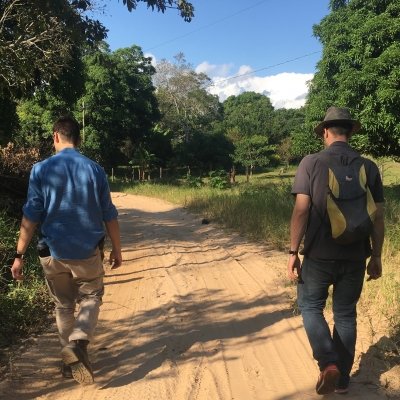
In keeping with University philosophy, Michigan Tech’s EWB chapter is currently working on two projects. In Guatemala, the group is focused on creating an improved water distribution system. In Bolivia, the goal is to improve a particularly treacherous road.
Josh Langlois, a fourth-year electrical engineering major and project lead for the Bolivia team, says the road is vital to the 50 or so families who live in Santa Barbara, a remote village north of Santa Cruz. The families, who practice subsistence farming, have poor access to surrounding communities, school programs, health care, and community gathering spaces.
“During the rainy season, from November to May, it’s hard to get to other places,” Langlois said. “We’re trying to design and build a new road system for them. The current road, when it’s not a river from all the rain, it’s all sand. We’re adding drainage and building a gravel road instead of sand so it can still be used in the rainy season.”
The Bolivia project is getting help from drone tech to build topographic maps—something engineers of earlier generations would have found very beneficial in their work. The group of roughly 30 students working on the project are putting considerable brain power toward analyzing topo data, road design, and figuring out drainage systems and culverts.
The students couldn’t go to Bolivia this past summer to work on the project due to the COVID-19 pandemic, but hope they’ll be able to return in summer 2021.
“It is very much a real engineering project, with real deadlines,” Langlois said.
Michigan Tech EWB Chapter Fall Fundraiser
The Michigan Tech chapter of EWB USA is hosting a fall fundraiser to support the students’ work in Bolivia and Guatemala. Alumnus Mike Paddock has donated copies of his book to be included as gifts for those who donate $20 or more to the student chapter.
The team anticipates the road project will take about nine years, which speaks both to the patience of the community and the ability of MTU students to foster lasting partnerships with communities and new students documenting the project and passing along the skills and knowledge they’ve developed as team members graduate and move into careers.
“We’re a team. Everyone in the chapter is there because they want to be there, they want to get things done and do it well for everyone else’s benefit,” Langlois said.
Despite the chapter’s demanding weekly schedule, Langlois said for him and many others in the group, it’s a passion project.
"I participate in Engineers Without Borders because I’ve always had a passion for helping people. Engineers Without Borders gives me a way to do that while using the skills I’ve learned at Michigan Tech."
A Legacy of Volunteerism
Michigan Tech’s chapter of Engineers Without Borders was one of the earliest of the national organization’s charters, and boasts an impressive alumni list. And while EWB didn’t yet exist while they were at Tech, Mike Paddock ’87 ’88 and Cathy Leslie ’83 have funneled time and energy into their alma mater’s chapter.
Paddock is so committed to helping students hone their skills that he published a book this year to share stories of engineers helping communities—he hopes it will inspire the next generation.
Paddock, honored this year with Michigan Tech’s Humanitarian Award for his work with EWB and other organizations, is grateful for his opportunity to serve. It almost didn’t happen.
He planned to volunteer when he retired and had more time. But in 1997, he was diagnosed with stage-four non-Hodgkin’s lymphoma. Paddock realized that time is relative: You have time for what you make time for. Despite a bleak prognosis, Paddock recovered and his cancer went into remission.
"I found myself unexpectedly still here. What do I do with this gift? My wife Cathy and I made up our minds to structure our lives so I could do service engineering."
As Paddock officially entered remission, he saw an article in Michigan Tech Magazine about a senior design project in Bolivia, under direction of Linda Phillips.
“I sent a note, asked if she needed a hand, the next thing you know I was on a flight to Bolivia,” Paddock recalled.
A Midwife, an Engineer, and a Bridge Over the River ‘Assassin’
Bridging Barriers tells the story of an engineer who helped a community solve their water troubles. Paddock’s book focuses on how the village of La Garrucha, a remote town in the Guatemalan Highlands, overcame two major barriers: the ferocious and unpredictable Rio Motagua river—one of Guatemala’s longest—and a lack of potable water. A midwife named Gavina had grown weary of not being able to help patients access medical care beyond what she could provide; the only way across the Rio Motagua was a foot bridge. Some tried to swim, giving the river its macabre nickname, “the Assassin.” Gavina knew that a vehicle bridge would greatly help her community.
Paddock tells the story of the projects and offers what he learned from the teacher who inspired his community outreach. “The purpose of the book is to pay forward the lessons I learned from my mentor, named Michael Shawcross, known in Guatemala as Don Mike,” Paddock said. “Writing the book wasn’t an option—for me it was an obligation. This book tells the story of the bridge project, the potable water project, and outlines 17 lessons learned from Don Mike. I tried to wrap them around fun stories to make it easy reading.”
"The desire for any change in a community must come from within the community itself. It takes patience to make sure that the right project is being done for the right people at the right time."
Engineers aren’t commonly thought of as good writers. Paddock’s knack for storytelling proves that assumption wrong. While weaving Don Mike’s lessons for engineers working in developing countries into the story, Paddock brings stories of La Garrucha’s people to life. Bridge workers eloped. The structure withstood Hurricane Agatha while other bridges failed. And at one point the entire water committee was arrested, as the community struggled with how to leverage fees to pay for water system and bridge maintenance.
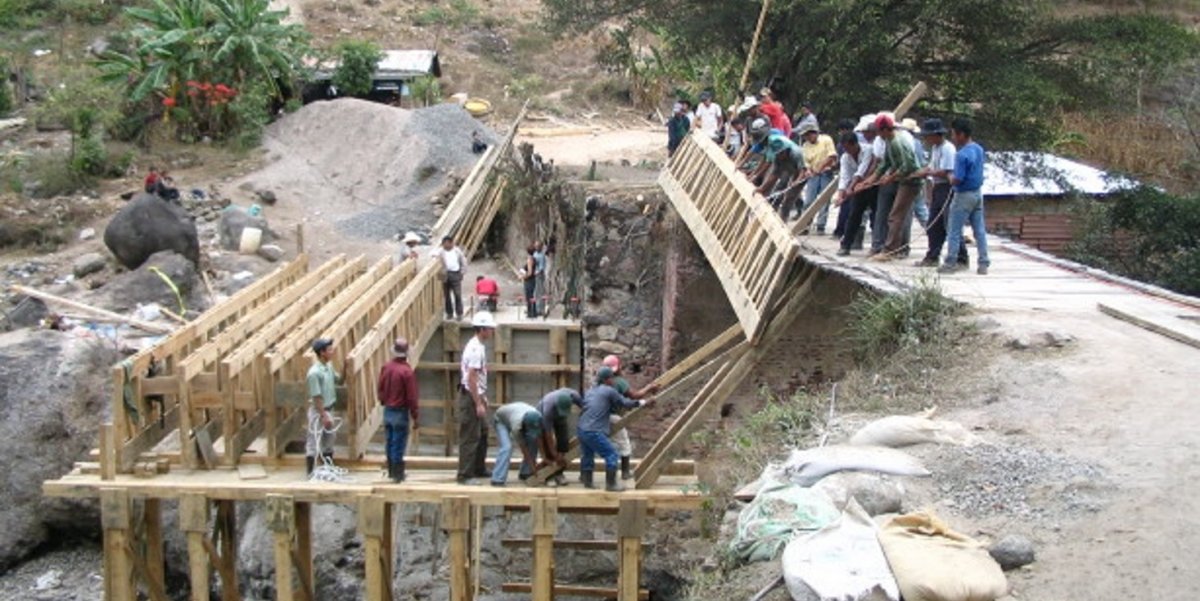
Bridging Barriers also records the 10-year bridge and water system project impact analysis Paddock undertook in 2018. Engineers Without Borders USA uses impact analyses to determine whether volunteer projects truly help the people they are supposed to serve. Were Don Mike, Paddock, and others successful in helping La Garrucha without introducing too many unintended consequences? Paddock, and EWB, wanted to know if the project lived up to the high bar Don Mike set for it: to empower the community to solve their problems.
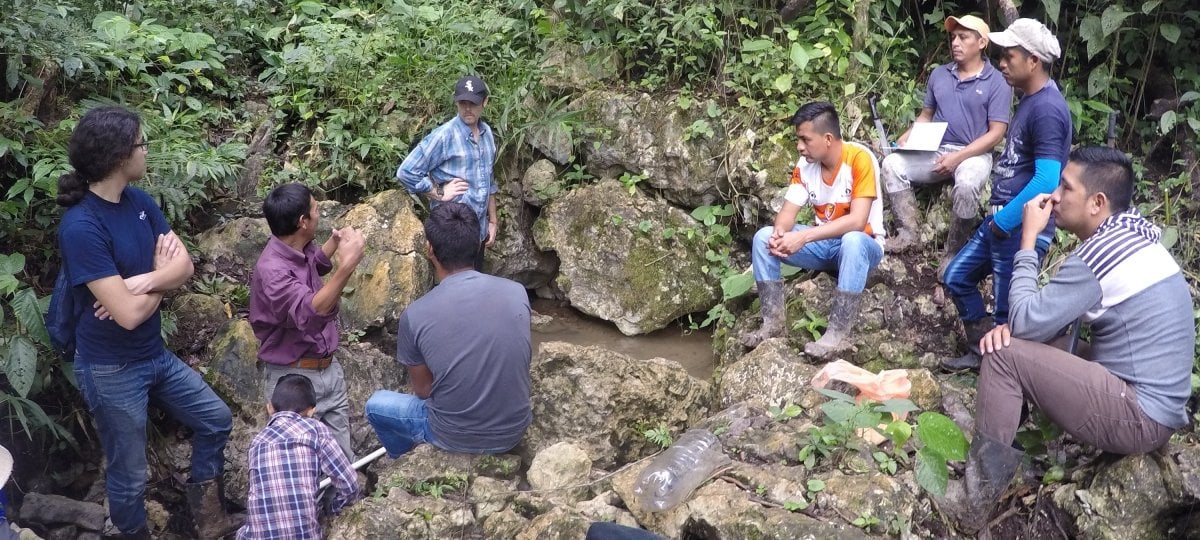
Paddock said the projects have indeed helped the people of La Garrucha.
“I was overjoyed—not only were the projects working, but once the barriers were removed to the community’s progress, they were able to take over and take control of their future,” Paddock said of his most recent visit. “They formed health care committees to look for vulnerable people in the community.”
"I could visualize Don Mike looking down from above and smiling … in the end, he would have given the program a grade of A-, because, in his words, ‘You should always be striving to do better.’"
As Don Mike’s work inspired him, so Paddock’s effort serves as an inspiration to the next generation of Michigan Tech engineers. And his work continues on other fronts: Paddock is on sabbatical from EWB in order to serve as a senior technical advisor for COVID-19 with the United Nations Development Programme to help communities access personal protective equipment.
Michigan Technological University is an R1 public research university founded in 1885 in Houghton, and is home to nearly 7,500 students from more than 60 countries around the world. Consistently ranked among the best universities in the country for return on investment, Michigan's flagship technological university offers more than 185 undergraduate and graduate degree programs in science and technology, engineering, computing, forestry, business, health professions, humanities, mathematics, social sciences, and the arts. The rural campus is situated just miles from Lake Superior in Michigan's Upper Peninsula, offering year-round opportunities for outdoor adventure.
